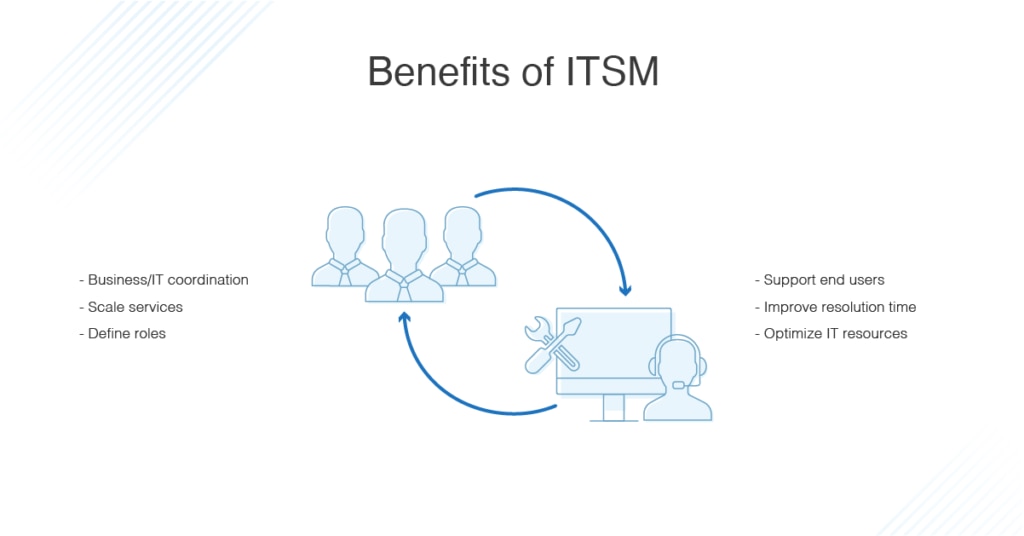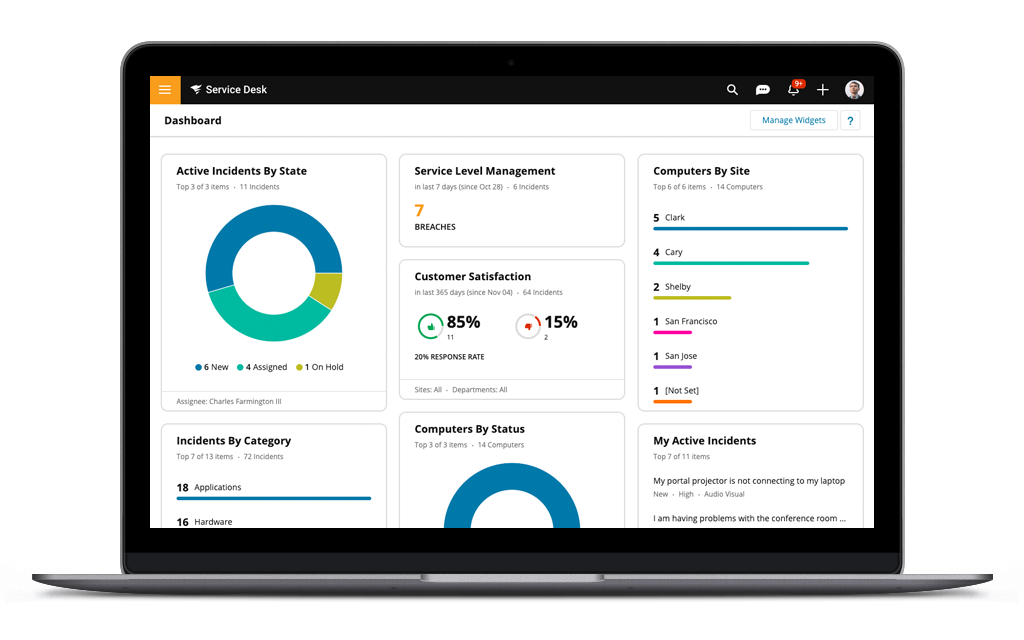IT service management, also known as ITSM, is a way for organizations to combine their business operations with their IT services. In an increasingly digital age, this process is becoming more important than ever. However, ITSM isn’t a new concept. In fact, it dates back to over 30 years ago when it was used in some of the world’s earliest data centers. In this blog, we’ll run through what ITSM is, discuss its importance and benefits, and walk through the various ITSM frameworks.
At the end of the day, it’s critically important to have an ITSM tool to help you achieve all the benefits of ITSM, and I recommend teams use SolarWinds® Web Help Desk® or Service Desk, as they’re both currently leading the market as the best tools built to support a total ITSM solution.
What Is ITSM?
Why Is ITSM Important?
What Are the Benefits of ITSM?
What Are ITSM Frameworks?
What Is ITIL?
What Is an ITSM Tool?
Best ITSM Tools Comparison
What Is ITSM?
ITSM refers to how technical teams design, plan, and deliver daily IT procedures to their customers and organizations. As technology continues to play an integral role in businesses, organizations need to find new ways to seamlessly bring IT service into day-to-day business operations. As opposed to traditional tech-driven IT management approaches, ITSM is all about creating a process-driven approach towards IT services. As such, its focus is on the customer’s needs rather than on traditional IT services.
In other words, unlike most IT management practices—which tend to focus on internal hardware, networks, and systems—ITSM leverages IT services to bridge the gap between how customer service aligns with business goals.
ITSM has changed a lot since its introduction in the 1980s when it was primarily used in data center management. Back then, it merely provided an organized approach to managing IT resources. Modern ITSM is far more diverse—it refers to overarching business and IT convergence practices.
There’s a good chance you already deploy ITSM processes in a small way at your company. As your organization grows, you’ll want to bring in more mature processes to get the maximum benefits out of your ITSM investments.
Why Is ITSM Important?
ITSM isn’t just a luxury or confined to service desk operations—it’s the method by which IT teams can deliver business value, and as such, it provides organizations with the potential to realize real business opportunities through the use of technologies.
As technology continues to play an important role in the business world, our understanding of what separates “business” and “IT” is blurring. For some companies, the divide between the two is almost nonexistent.
For example, a sales team member probably needs to operate sales software every day, or a warehouse manager might need to use a supply chain platform to ensure shipments are sent and received properly. These kinds of tools require at least a small amount of technical skill. Likely, though, these employees don’t have any technical background whatsoever. As such, IT solutions need to be integrated into these processes to ensure day-to-day business is running smoothly and all workers are using technology to its full potential. That’s what ITSM helps accomplish.
What’s more, ITSM is important because it seeks to help companies answer three fundamental questions about their business:
- How can our technologies work together to improve services?
- How do these services create new business opportunities?
- How can we better leverage our IT capabilities?
With a better understanding of these questions, business leaders and CIOs can make better decisions about their technological investments and get more out of their IT resources.
What Are the Benefits of ITSM?
Because ITSM is about improving both IT and business, there are benefits to be had in both departments. With ITSM, IT teams can:
- Enable technical teams to obtain a better understanding of what business teams need and why
- Scale their services
- Help admins define internal roles and responsibilities
- Increase worker productivity
- Help ensure performance and productivity for end users
- Improve mean time to resolution when issues occur
- Help IT teams establish more proactive performance and security measures
- Optimize their ability to locate and solve recurring problems
- Receive better analytics to measure and improve overall IT workload
On the other hand, ITSM has many benefits for business ops, including:
- Business teams can take advantage of when innovations or changes occur in your industry or in the market
- IT services are more available, which in turn equates to better employee performance and increased bandwidth
- IT issues occur less frequently, cause less damage, and aren’t as costly
- Non-technical employees know what IT services are available and are better trained to use them
- The business receives better ROI on IT-related purchases
- The business can better maintain compliance with regulatory guidelines

What Are ITSM Frameworks?
ITSM is made up of many IT management frameworks, some of which are designed to address unique industry-specific IT needs, like healthcare, government, or education.
More specifically, ITSM frameworks include IT services like quality management, software engineering, change management, information security management, and more. Due to the specificity of these frameworks, many people refer to ITSM as “IT as a service.”
Some popular ITSM frameworks are:
- Business Process Framework (also known as “eTOM”): This framework is best used by telecommunications service providers. The model helps define and improve the critical elements between businesses and their service providers.
- Microsoft Operations Framework (MOF): This framework is made up of a compilation of 23 documents to walk businesses through their entire IT services lifecycle. They include everything from creation and implementation to cost management. MOF operates with a specific focus on Microsoft technologies.
- FitSM: This is often referred to as a standard more than a framework and is most frequently used in lightweight IT service management.
- Control Objectives for Information and Related Technologies (COBIT): This framework is frequently used as an IT governance framework.
- ISO/IEC 20000: This was the first international standard for IT service management and delivery. Its focus is on improving service management systems of different varieties.
- Six Sigma: This framework helps organizations use data analysis to minimize product and service flaws. It was first developed by Motorola.
- The Open Group Architecture Framework (TOGAF): This framework was created and managed by The Open Group—a well-known industry consortium. It helps businesses achieve better IT structure when implementing new technology, especially for new software investments.
- ITSM Maturity Model: This is something a tad different from the above, but just as useful. The ITSM Maturity Model is a framework that will help you estimate the sophistication of your service management – it will show you what is working well at your company and what you still need to work on. In one of our articles we explained exactly how it works. You can find it here: What is an ITSM assessment, and how does an ITSM Maturity Model help?
What Is ITIL?
The most common framework used in ITSM is the Information Technology Infrastructure Library, also known as ITIL. ITIL can best be understood as a library of volumes describing best practices for deploying IT services effectively.
The ITIL framework is designed to empower IT admins to act as business partners as opposed to just back-end support. Although sometimes used interchangeably, ITSM and ITIL are not one and the same. While ITSM serves as the actual practice of using IT operations as a service, ITIL defines a specific set of best practices to help IT teams perform better ITSM.
ITIL has gone through many revisions since its inception in the 1980s. Currently, ITIL encompasses a framework of five core publications, which are reviewed and updated as technologies evolve. The “books” contain best practices for each pillar of the IT service management (ITSM) lifecycle. The libraries and their core concepts are:
- Service Strategy: This library is meant to define the business goals and customer requirements of your organization. It helps IT teams align the objectives of both parties.
- Service Design: This library outlines production practices for IT policies, architectures, and documentation.
- Service Transition: This library provides IT teams guidance on change management and release practices. It can also lead admins through any network interruptions and changes.
- Service Operation: This library supports the ways IT manages their support services, from a day-to-day basis up to a yearly basis.
- Continual Service Improvement: This covers how IT teams can introduce improvements and policy updates within the overall ITIL framework.
Each of these libraries in ITIL service management processes can be updated and adjusted to meet the needs of current infrastructure landscapes. Overall, this systematic approach to ITSM is designed to help businesses develop better risk assessment, improve client relations, develop cost-effective practices, and establish a stable IT environment that can be scaled and modified as your company grows and changes.
You can read my ITIL guide for more in-depth information about ITIL.
What Is an ITSM Tool?
ITSM tools are designed to regulate how IT services are delivered within a company, based on budgets, people, processes, and outcomes. Although many people might think ITSM tools are just beefed up help-desk tools, the truth is, ITSM tools are different. A real ITSM tool should contain the following:
- Incident management
- Ticketing
- IT service models
- Asset management tools
- License management
Best ITSM Tools Comparison

If you’re looking for help desk tools with ITSM capabilities, start with SolarWinds Web Help Desk or Service Desk. These tools offer similar capabilities around incident management, service desk ticketing, asset inventory management, licensing, and more. You gain features like a centralized dashboard, automatic alerts and escalation, and built-in reporting to make implementing better ITSM practices a snap.
SolarWinds ITSM software was a 2018 Gartner Peer Insights Customers’ Choice for ITSM web help desk solutions. It’s proven to help organizations simplify day-to-day IT tasks, improve employee services, and boost business productivity.
Service Desk extends the capabilities of a usual IT service desk with tons of helpful capabilities. For one, users are given access to best-in-class service desk reporting tools to help them consolidate IT data, so they can evaluate what IT services are delivering the most value to their organization. This feature allows users to report on SLA breaches, CSAT scores, ITIL processes, and overall time-to-resolution metrics, so they can make objective measures of how their services are faring. Although many service desks help IT teams manage daily tasks, none are quite as robust and organized SolarWinds ITSM software.
